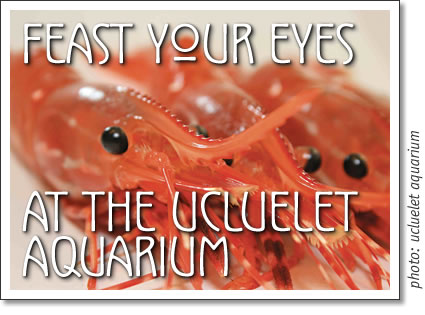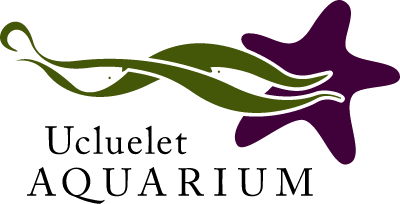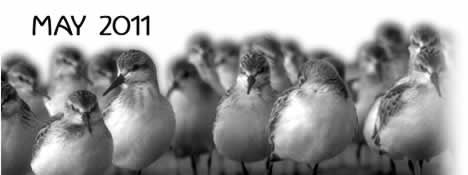
Feast your eyes at the Ucluelet Aquarium
by Bill Morrison, Ucluelet Aquarium
 May is a time for a Feast! So it is too in the ocean around us as more sunlight and warmer temperatures fuel an explosive growth of plankton which, in turn, feeds all the creatures in the sea.
May is a time for a Feast! So it is too in the ocean around us as more sunlight and warmer temperatures fuel an explosive growth of plankton which, in turn, feeds all the creatures in the sea.
At the Ucluelet Aquarium, we love all the animals in our care. We like collecting them, displaying them for visitors and releasing them back into their home habitats. We like telling stories about them, feeding them and just watching them. We like photos of them, new research about them and even songs about them. We make ‘nudibranch’ jokes. But when the visitors have left and the lights are turned off, some of us go home, grab our fishing licenses, rods & traps and go to seek their comrades for another purpose. We love eating some of them.
“Prawn” - is there a more beautiful word in the english language? There are many species of prawns & shrimp in our waters and lots in our tanks. The star of the show is the the Pacific Prawn (more commonly known as the ‘spot prawn’). They glow with iridescent oranges, silvers & white. They have big black eyes and their outrageous antennae sway in the current seeking the scent of dinner. They don’t bother their tank mates. They eat dead things. They are the perfect aquarium animal. I love prawns.
A visit to the aquarium is guaranteed to leave your ears ringing with crab stories. We have plenty (species of crabs, that is). The one most likely to find its way onto your plate is the Dungeness crab. Some tourists like to visit our coast specifically to eat them and who can blame them? In the aquarium we usually have a bunch living together - often peacefully and occasionally not. It is fascinating to see them bury in the sand with just their eyes sticking out. As with prawns, it may be best not to ask what they have had for lunch.
It is sometimes difficult for our visitors to believe that barnacles are crustaceans like the shrimp & crabs. The Goose-neck Barnacle is, let’s face it, odd. They are very highly-esteemed in the best tapas bars of Madrid. Their flesh can be bright red and strong-tasting. When you consider that they live in the most violent environment imaginable on the wave-swept outer coast, it is understandable that they are hard to keep in the aquarium. When we get some that have broken off their home rock and have been tossed onto the beach, we keep them under the strongest water flow we have.
Fish matter. Some of our guests look at a tank full of anemones, stars and chitons and ask us why the tank is ‘empty’. About salmon much has been written. We keep some baby coho & chum salmon from Thornton Creek Hatchery in our only fresh-water tank. We applaud our neighbours who are working so hard on behalf of what might be the most important fish in our waters. Lingcod are marvelous on the plate but a bit of a problem in the aquarium because of their own love of feasting. I once caught an 8-inch lingcod on a 5-inch buzz bomb. A tank with a lingcod in it soon becomes a tank with only a lingcod in it. My favourite fish to eat, the halibut, is too big for our aquarium. But check out the Pacific Canada exhibit at the Vancouver Aquarium sometime. Awesome. We like to display brightly-coloured juveniles of many species of rockfish (a.k.a. ‘rockcod’). It cannot be denied that these fish make fine eating, but the fact that some species take many many years to reach maturity (and there are, as a result, widespread conservation concerns) suggests that we prefer to eat other fishes.
And now to the molluscs. The most charismatic animal in the aquarium is the Giant Pacific Octopus. The biologist in me wants to say that each individual displays idiosyncratic responses to various stimuli. But the aquarium-lover says each octopus has its own personality. Most seasons, we will have a couple of different octopuses stay with us. This is because of their phenomenal growth rate. They just get too big, too fast. Maybe this is because they too are sophisticated diners (though not into ‘small-plates’). Our octopus, regardless of personality, usually eats one or more Dungeness or Red rock crabs each day. Diners in Europe and Asia have long appreciated the tricky-to-prepare octopus. Some of our local chefs are now serving up amazing octopus dishes.
A relative of the octopus, the opalescent squid, will soon be streaming into the Ucluelet Harbour. Like many animals which live in huge schools (herring & anchovies for example), they do not adapt well to our smaller tanks and we do not display them. I prefer them to be displayed “Salt-and-Pepper” style at our local Chinese restaurants.
Westcoasters love their bivalves. Oysters, mussels, clams mmmmmm. We have a neat display of clusters from a Lemmens Inlet oyster farm. It is stunning to see the life that lives on top of these. We are always happy to show off the diversity of clam species (geoducks, horse clams, razors, butters, Manila, littleneck and the ‘newcomer’ varnish clam). The cockles and swimming scallops are counted on all summer to perform their dramatic escape responses from the gluttonous sunflower stars. At the end of the day, however, we see bivalves as ‘winter’ food. This is partly because they are filter feeders and can accumulate toxins in the warmer months (some plankton species are poisonous to humans). In addition, as the ocean water warms, these bivalves direct energy from their yummy muscle tissue to produce not-so-yummy reproductive tissue (eewwwww).
One bivalve is exempt from the discussion above: the rock scallop. This animal is another ‘perfect’ aquarium animal. It takes up little space and many animals live on it (including the lurid Yellow Boring Sponge – ‘boring’ as in ‘drilling’, not as in ‘ho-hum’). When it is feeding, you can see its bright orange innards bracketed by many sapphire-like ‘eyes’. Beautiful. Yummy too. At the Ucluelet Aquarium we take great pride in returning all our animals to their home habitats at the end of the season. While we have great trust in our staff, the rock scallop release is always a chaperoned event.
So many species, so many dining options. We have three species of sea urchins to show you. Urchin roe, as ‘uni’, is often the highlight of a sushi diner’s evening. Sea otters would agree. The Black Leather Chiton, tenderized by pounding, is served at potlaches and other events up and down our coast. I have enjoyed a campfire meal of Black Turban Snails (hint: bring safety pin). We can usually perplex at least one aquarium guest per day by informing him or her that, “Yes, people actually do eat sea cucumbers.” The list goes on. The ocean feeds us. It makes sense that we should try to take good care of it.
So after an evening of fine dining, when the seafood on your plate was transformed into a piece of art, consider a visit to the Ucluelet Aquarium. Get connected with your food. See how these beautiful animals live and hear their stories.
Open daily: 10 a.m. - 6 p.m.

Bill Morrison is a volunteer with the Ucluelet Aquarium Society.
Ucluelet Aquarium articles
- Ucluelet Aquarium: Things you can't see in the Wild June 2010
- Feast your eyes at the Ucluelet Aquarium May 2011
- Snails & Seaslugs at Ucluelet Aquarium June 2011
Tofino Time May 2011
- Tofino in May 2011
- Tofino event listings for May 2011
- Tofino concerts in May 2011
- Tofino movies in May 2011
- Tofino tide table for May 2011
- Tofino surf reports for May 2011
- The year of Tofino Beer: Tofino Brewing Co.
- Salmonberry Spring in Tofino
- Feast your eyes at the Ucluelet Aquarium
- Tofino yoga classes May 2011
- Tofino Shorebird Festival: May 6-8, 2011
- Feast! Tofino-Ucluelet Culinary Festival
- Open House on Clayoquot Island
- Tofino wellness: Fight off Allergies this Season!
- Tofino gardening in May 2011
- Horoscope for May 2011
- Community Directory: Goods & Services in Tofino
tofino | tofino time | activities | accommodation | events | directory
maps | travel | food | art & artists | photos | horoscope | tides
search | magazine | issues | articles | advertising | contact us
hosted in tofino by tofino.net & studio tofino
© 2002-2014 copyright Tofino Time Magazine in Tofino Canada
 Feast your eyes at the Ucluelet Aquarium: News and goings-on from the Ucluelet Aquarium in May 2011.
Feast your eyes at the Ucluelet Aquarium: News and goings-on from the Ucluelet Aquarium in May 2011.

quick links:
- tofino accomodations
- tofino calendar
- tofino surf report
- tofino horoscope
- march horoscope
- tofino map
- tofino fishing report
- tofino tides
- tofino weddings
tofino events:
- tofino concerts
- tofino events
- tofino movies
- tofino festivals
- tofino yoga classes
- tofino whale festival
tofino time magazine:
- tofino time march 2016
- tofino event listings march 2016
- tofino concerts in march 2016
- tofino movies in march 2016
- cox bay | wickaninnish beach
- chesterman beach
- tonquin beach
- tofino brewing co.
- tofino wedding guide
tofino accommodation:
- tofino cabin
- tofino camping
- bed & breakfasts in Tofino
- tofino hostels
- tofino motels
- tofino hotels
- tofino vacation rentals
- petfriendly accommodation
activities:
- tofino bike rentals
- tofino bear watching
- tofino bird watching
- tofino boat charters & cruises
- tofino fishing
- hot springs cove
- sea kayaking in tofino
- tofino storm watching
- tofino surfing
- tofino whale watching
- tofino yoga
shopping:
services:
- tofino yoga, spa & wellness
- tofino restaurants
- tofino internet cafes
- tofino travel & transportation
- tofino real estate
- tofino taxi services
- tofino wedding & events
